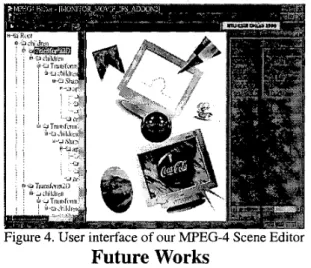WAM 9.1
Editor Kernel
On the Design and Implementation of an MPEG-4 Scene Editor
-
RenderDeng-Rung Liu, Meng-Jyi Shieh, Yu-Chung
and Wen-Chin Chen
DMIF 'Communication and Multimedia Lab.,
Department of Computer Science and Information Engineering, National Taiwan University, Taipei, Taiwan
2CyberLink Inc., Taiwan
E-Mail: {drliu, feitian, cotta, wcchen}@cmlab.csie. ntu. edu. tw
Codec Bank
Abstract
A prototype of MPEG-4 scene editor h a s been developed
in the joint research of our laboratories and CyberLink Inc. With this scene editor; users can compose and edit object-oriented multimedia contents conforming to MPEG-4 [ I ] specification. The system is currently developed on Microsoft Windows platform. We describe in this paper the system architecture as well as the design and implementation issues of the scene editor. We believe our development experience can benefit future developers of MPEG-4 system.
Introduction
MPEG-4 is the state-of-the-art standard for describing the presentation and composition of multimedia contents. The contents integrate different media data in an objected-based way. The specification of MPEG-4 includes media data access framework, video/audio codec, synthetic object presentation and integration method of different media data. We have developed a multimedia MPEG-4 scene editor based on the specification. The prototype system is developed on Microsoft Windows platform.
Architecture
Our system consists of five modules. They are Editor Kernel, Render, SmartProxy, DMIF, and Codec Bank. Editor Kernel is responsible for processing the construction of a scene description and activating the other modules in the initial phase of the program execution. Render module is responsible for composing different media objects and performing certain synchronization checks in rendering. The purpose of the DMIF module is to provide a uniform interface to access the data transmitted by different network hardware devices and protocols. Similarly, as there are different
playback the scene[5,7], Editor Kernel will invoke BIFS
Operating System SDK Support
Compiler CPU
decoder to decode the scene stream from DMZF and then restore the original scene description tree. With this scene description tree, Render can compose other media
Microsoft Windows 98/Windows 2000 Microsoft DirectX 7.0 Microsoft DirectX Media 6.0
Microsoft Visual Studio 6.0
Intel Pentium 111-500 streams from Codec Bunk to generate the correct scene.
BiFSDgader
Figure 2. Flow of scene stream from DMIF to Render. With the input and output interface of our Codec Bank, we can ignore the difference between source media data as described in Figure 3. The Smartproxy module is mainly for coordinating different decoders.
Figure 3. Codec Bank and DMZF, Smartproxy
Future Works
We expect to finish the following works in the second year of our MPEG-4 system development:
In DMZF, our system needs to support remote media data access.
The synchronization control is currently implemented in Render module. This however does not conform to the MF’EG-4 specification. Besides, in our system the Codec Bunk accesses and decodes data directly from DMZF. This approach is quite inefficient for the synchronization. We intend to move the load to Editor Kernel and thus follow the synchronization method described in the MPEG-4 specification. More decoder filters will be implemented and included in our Codec Bank.
Reference
ISO/IEC FDIS 14496, Information Technology
-
Generic Coding of Audio-visual Objects-
Part 1, Part 2, Part 3, Part 6, Intemational Organization for Standardization,1998.
Intemational Standard ISO/IEC 14772-1: 1997.
ISO/IEC IS 10918, Information Technology
-
Coding of Moving Pictures and Associated Audio for Digital Storage Media up to about 1.5 Mbit/s-
Part 2, Part 3, Intemational Organization for Standardization, 1991. ISO/IEC IS 13818, Information Technology - Generic Coding of Moving Pictures and Associated Audio Information-
Part 2, Part 3, International Organization for Standardization, 1994.Video For Window, Microsoft Corporation.
DirectX Media, Microsoft Corporation, October 1998. PC Video Synchronization and Playback, Microsoft Corporation, November 1998.
